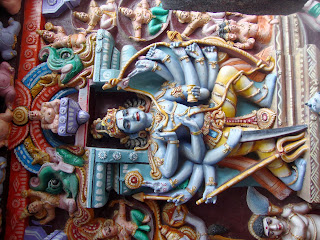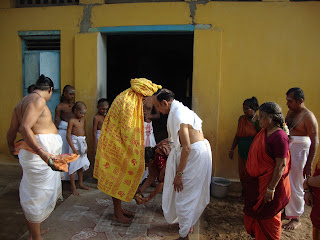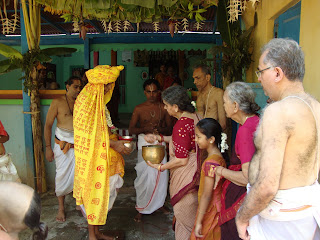Kadambur Temple resembles an art gallery with
beautiful pieces of 12th century art and monuments. Kadambur is the 34th in the
series of the Tevara Stalams located in Chola Nadu north of the river Kaveri.
Legends: Indra worshipped Shiva here, to obtain the celestial nectar Amritam and hence temple is known as Karakkovil.
Temple: This temple covers 3.4 acres. The main temple is shaped like a chariot with wheels and horses. The vimana is known as Indra Vimanam. Entering the main gateway, one finds a porch and a mandapam containing bronze images. On reaching the Southern Prakaram, the main temple comes into view. Found in its original form, it has very graceful lines and is covered in sculptures. Built like a chariot with two wheels on each side, and is drawn by caparisoned horses in prancing posture with Shiva as its occupant. The walls of the sanctum and the ardhamandapam are covered with sculptures in bas relief.
The sanctum has images of Dakshinamurthy, Vishnu and Bhrama, while the ardhamandapam has those of Ardhanareeswarar (south) and Alinganamurthy (north). Vinayakar and Agastyar are found on either side of Ardhanareeswarar. There are a series of sculptures of rishis and gods who worshipped Shiva. The bronze images are housed in this temple. The Nataraja image, depicts Shiva dancing on Nandi. This temple is the finest example of the existing temples from the age of Kulottunga Chola I (1075-1120).
Legends: Indra worshipped Shiva here, to obtain the celestial nectar Amritam and hence temple is known as Karakkovil.
Temple: This temple covers 3.4 acres. The main temple is shaped like a chariot with wheels and horses. The vimana is known as Indra Vimanam. Entering the main gateway, one finds a porch and a mandapam containing bronze images. On reaching the Southern Prakaram, the main temple comes into view. Found in its original form, it has very graceful lines and is covered in sculptures. Built like a chariot with two wheels on each side, and is drawn by caparisoned horses in prancing posture with Shiva as its occupant. The walls of the sanctum and the ardhamandapam are covered with sculptures in bas relief.
The sanctum has images of Dakshinamurthy, Vishnu and Bhrama, while the ardhamandapam has those of Ardhanareeswarar (south) and Alinganamurthy (north). Vinayakar and Agastyar are found on either side of Ardhanareeswarar. There are a series of sculptures of rishis and gods who worshipped Shiva. The bronze images are housed in this temple. The Nataraja image, depicts Shiva dancing on Nandi. This temple is the finest example of the existing temples from the age of Kulottunga Chola I (1075-1120).





























































